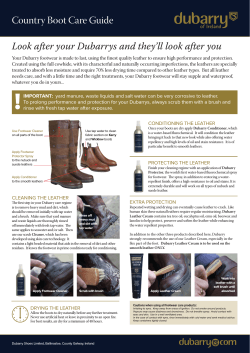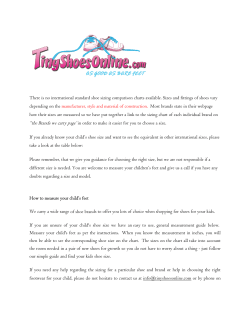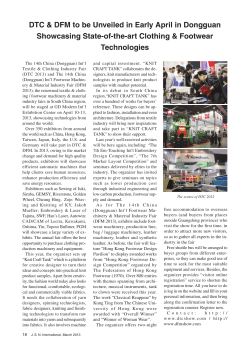
5 DAYS COURSE AT FFANY, New York City
5 DAYS COURSE AT FFANY, New York City INTRODUCTION In the recent years the shift of the production of the US companies to the Far East factories has led to a lack of technical knowledge in the US. The new generation of the footwear professionals (those working in the field of product development and in other roles related to the product such as product management, design, merchandising, costing, planning) does not have a factory/manufacturing background. Most of the times they come from fashion/industrial design or management studies. The recent crisis has often led to a cut of travelling expenses. And the young people working in the US footwear companies often have not even visited a footwear factory. In 2007 Ars Sutoria school has decided to organize technical courses in the US geared around the needs of this new generation of footwear professionals. Few years later we have two training programs: one in Boston (with the support of Two Ten) more focused on casual/performance shoes and one in New York (with the support of FFANY) more focused on elegant/casual shoes. TARGET ATTENDEES WHAT TO EXPECT Profile: primary product development, but also product manager, designer, merchandiser and line builder. Experience: at least three years in the field of footwear. Greater understanding of the processes of production of different types of shoe constructions and deeper knowledge of the materials used in each stage of the process. An opportunity to refocus the experience and progress in a job that requires the ability to thoroughly analyze the product and interact with professional engineers from the overseas manufacturing of sample rooms and factories FOCUS ON Casual and elegant shoes. The course will see the presence of a specialist in shoe fitting tests. CONTACTS Wendy Sani Ars Sutoria wendy@arssutoria.com www.ffany.org Liz Carroll FFANY lcarroll@ffany.org www.arssutoria.com DETAILED AGENDA OF TRAINING TOPICS Part I. Fundamentals of shoemaking Analysis of footwear families and glossary: Oxford, Derby, Pump, Sandal, Clog, Moccasin, Boot, Women’s footwear terminology, Men’s footwear terminology Overview of cemented construction process: Styling, Project, Pattern Making, Construction, Manual operations, Machine processes Shoe constructions: Cemented, Blake-McKay, Goodyear, Stitched out, San Crispino, Opanka, Moccasins, Inside-out, Stapled/studded, Slip-lasting, Strobel, String lasting, Direct rubber vulcaniztion, Built-up, Direct Injection Part II. Components and Materials The Last: Overview, Foot shapes, Angles and inclination, Volumes, Proportions, Styling, Last modeling, Good fitting tips, Last measurements Cutting: Manual, Press, Computer-aided Upper and lining preparation: Splitting, Skiving, Taping, Backing, Edge finishing, Upper assembly Upper pre-lasting and lasting: Toe and box bonding, Insole attaching, Vamp moulding, Toe box reactivation, Lining and preparation, Topline nailing, Side and heel lasting, Sanding and flattening, Heel seat flattening, Sanding and pounding, Heel attaching, Tack removing, Delasting Design and pattern making for shoes and boots: Traditional by hand, Computer-aided Shoe Structure: toe boxes, back counters and lasting insoles Toe boxes production, Back stiffeners production, Lasting insoles, Metal shanks, Insole reinforcements Heels: From idea to production, Correct measuring, Heel types, Materials Attachment, Mould, Leather stacking, Spraying, Wire sprayed, Photographic process, Quality of heel fit www.ffany.org www.arssutoria.com Leathers: Animal skin to leather, Showcase of different hides, Subdivision of leather, Tickness requirements, Splitting process, Design and leather grains, Primary leathers, Reptiles and exotics, What is CITES Leather Tannage: Vegetable, Mineral, Synthetic, Mixed, Aldheyde, Oil Fabrics / Textiles: Weaving, Fabrics vs. Synthetics Nesting of patterns for cutting: Rules to save on costs, Manual nesting, Software nesting Part III. Pattern making and last analysis focus During the final day of the course there will be a deeper focus on a more advanced level of pattern making and last analysis. Hands-on demonsration will be done by instructor with partecipation of attendees. · Draw design directly on last · Analysis of fit problems that can arise from an incorrect last, incorrect pattern or incorrect lasting (construction) during assembly · Example of pattern engineering · Numerical measurements are explained more in depth · Analysis of common quality and fit problems · Details of shoe, sandal and eventual boot patterns are examined in order to avoid possible fit problems Time is saved for Q/A with instructors after each topic is addressed and especially for additional isssues interesting partecipants. www.ffany.org www.arssutoria.com
© Copyright 2025





















